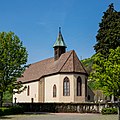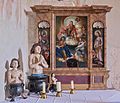St. Vitus (Wasenweiler)
St. Vitus is a chapel on the southern edge of the Kaiserstuhl . It is located in the Neunkirch von Wasenweiler residential area , a district of Ihringen , halfway between Wasenweiler and Ihringen. Until 1716 the chapel was parish church, first of Wasenweiler and Ihringen, after the Reformation, when Ihringen became Protestant, only from Wasenweiler. Today it is a cemetery chapel and belongs to the parish Wasenweiler / Ihringen of the Merdingen pastoral care unit . It is known in art history for its medieval wall paintings and the altarpiece attributed to Sixt von Staufen .
history
The beginnings are unsure. A mill in Nünkilche is mentioned for the first time in 1314, the Vitus Church in archives from the 13th century. But she is older. A baptismal font or holy water basin, which is said to come from the church and is now in the Baden State Museum in Karlsruhe, was dated to the 9th or 10th century by the Freiburg theologian and art historian Joseph Sauer, and to the 12th century by later investigators. The barrel-vaulted sacristy is probably just as old, originally, as can be seen from the piscina , a room for the celebration of Holy Mass . The ship is younger. In the 11th century Wasenweiler was owned by the Alsatian monastery of Murbach . In 1275 it was the seat of a deanery , which was later moved to Breisach . From 1290 to 1371 the coming of the Teutonic Order in Freiburg im Breisgau came in several steps . The German rulers extended the nave to the west, increased it by 2 m and added the choir in the 15th century. Most of the wall paintings in the nave and choir also date from the 15th century. The year “1492” is carved over the passage from the choir to the sacristy, an ante quem term for the painting that was damaged when it was broken through. In the 17th or 18th century a fire destroyed the cross vault of the choir, which was then replaced by a flat ceiling. A gallery was built in the west in 1664, and gradually the wall paintings disappeared under an increasingly thick layer of plaster. "St. Vitus fell asleep. "
In 1850 the church was on the verge of collapse and consideration was given to demolishing it. Alternatively, they could be "left as a ruin to decorate the landscape". With the help of a private collection, however, it was repaired. Another renovation took place in 1914. From 2005 to 2010 the frescoes were restored. In 2011 the chapel received the carved wood altarpiece back, which had been relocated during World War II and then kept in the Augustinian Museum in Freiburg .
building
The chapel is in the middle of the cemetery. It consists of a nave measuring around 10 × 8 m inside in the west, the choir with a roof turret in the east, which closes on three sides of the octagon, and the sacristy that adjoins the choir to the north. In the west a pointed arched entrance leads into the ship, in the south a just closed entrance. The ship's windows are irregularly designed, while the choir receives light through a two-part lancet window with fish-bubble tracery in the three sides of the polygon and another, later, smaller and deeper lancet window in the south wall. Before the breakthrough from the choir into the sacristy in 1492, the sacristy was accessible from the nave. The consoles for the former cross vault have been preserved in the choir. On the north wall choral a 1502 or 1507 is dated tabernacle mounted.
Furnishing
The murals were discovered and uncovered by Joseph Sauer in 1919. They are painted onto the dried plaster using the Secco technique .
- Mural
A crucifixion , three saints and two scenes from the legend of St. Vitus are depicted on the southern triumphal arch wall. On the south wall of the nave there are additional Vitus scenes 1, 2 , interrupted by St. Christopher above and next to the south entrance 1 , in three horizontal stripes one above the other in framed fields . On the north wall of the triumphal arch, largely covered by the baroque retable (see below), St. Anthony the Great can be seen. On the north wall of the ship, Christophorus appears again on the left, next to him are Saints Barbara of Nicomedia and Catherine of Alexandria and, on the right, the Mother of God with the Child, above Saint George 3 .
The more recent paintings on the walls and in the window reveals of the choir form a cycle of the apostles - above a 1.5 m high brown base zone with cuboids drawn in white. They stand with illegible banners on a green background decorated with tendrils and flowers. The series begins in the north with the group of three 4 of Peter with a large key, John with a chalice and James the Elder with his pilgrim's staff, which Joseph Sauer initially took for Paul with a sword. The series is then interrupted by the tabernacle within an architectural painting that takes on its form. In the reveal of the left polygonal window in the choir, Andreas and Philip face each other, in the reveal of the middle polygonal window Jesus and Thomas , in the reveal of the right polygonal window Bartholomäus and Matthew . The following group of three in the south is disturbed by the later break-in of the smaller lancet window. The last field shows James the Younger and Jude Thaddeus 5 .
Franz Xaver Kraus , from whom the frescoes were still hidden, describes the high altar retable in 1904 in his art monuments of the Grand Duchy of Baden : “The three-sacred altar cabinet contains polygonal niches in the three top, enclosed by twisted branches, spanned by small star vaults and broken at the back by two-sacred tracery windows three standing figures about 1.10 m high. <...> In the raised central niche the Madonna stands on the crescent moon with the naked Christ child on her arms. ”On the left it is about St. Nicholas of Myra with the three gold balls on the book, on the right the holy deacon Stephen in richly decorated dalmatic , in which the stones of his stoning ( Acts 7.54-59 EU ) were lost. Ingeborg Krummer-Schroth attributed the work to Sixt von Staufen, especially by comparing it with the Locherer Altar in Freiburg Minster : “In the niches, the middle one is higher, there are the figures of Our Lady, a holy bishop (Nicholas?) and a holy deacon (Stephen?). A rich, dense tracery with thorn leaf tendrils in which birds sit (in the Locherer altar there are angels) fills the area in front of the small vaults above the saint. It grows from bark-like branches, some of which intersect with grooved architectural profiles that swing out from the rod-like pillars. This tracery is so closely related to the Locherer altar in its entire formation as well as in the carving method that we can probably infer a common master hand. "
Kraus qualified the two side altars as "insignificant Renaissance works". Only the left one is left. Its side paintings, probably still baroque, show St. George on the left and St. Elisabeth of Thuringia on the right . The middle painting, signed “Fidelis Liebenstein 1803”, an otherwise unknown painter, shows Vitus with his tutors, St. Modestus and St. Crescentia . Oil is boiled among them, into which all three were thrown during their martyrdom. On the altar are three different sized sculptures for the same scene, either all meaning Vitus, the saint better known thanks to his inclusion among the fourteen helpers in need , or himself with his tutors.
Web links
literature
- Neunkirch / Wasenweiler . In Hermann Brommer , Bernd Mathias Kremer , Hans-Otto Mühleisen : Art at the Kaiserstuhl. 2nd Edition. Kunstverlag Josef Fink, Lindenberg im Allgäu 2008, ISBN 978-3-89870-284-3 , pp. 89–91.
- Ernst Heim: Former parish church of St. Vitus zu Wasenweiler. Ihringen without year (around 2011)
- Franz Xaver Kraus : The art monuments of the Grand Duchy of Baden . Volume 6, 1 The art monuments of the districts of Breisach, Emmendingen, Ettenheim, Freiburg (Land), Neustadt, Staufen and Waldkirch (Freiburg Land district). Verlag JCB Mohr, Tübingen and Leipzig 1904, pp. 107-111 ( digitized version ).
- State Monuments Office Baden-Württemberg and District Office Breisgau-Hochschwarzwald: District of Breisgau-Hochschwarzwald. List of cultural monuments. I. The architectural and art monuments of the former Freiburg district. Freiburg im Breisgau 1974.
- Neunkirch on the Landeskunde website, discover Baden-Württemberg online. Retrieved April 11, 2014.
- Hans-Otto Mühleisen: Wasenweiler - Parish Church of the Assumption - Vitus Chapel (Neunkirch). Kunstverlag Josef Fink, Lindenberg im Allgäu 2014. ISBN 978-3-89870-490-8 .
- Helmut Naumann: The apostles cycle from Neunkirch. In: Freiburger Diözesan-Archiv 82/83, 1962/63, pp. 532-540 ( digitized version ).
- Joseph Sauer : The Vitus Chapel in Wasenweiler and its wall paintings. In: Heimatklänge. Supplement to the Freiburger Tagespost. Freiburg im Breisgau 1920.
- Wasenweiler in: State Archive Administration Baden-Württemberg: Freiburg im Breisgau, city and district, official district description Volume II, 2. Rombach, Freiburg im Breisgau 1974, pp. 1138–1154
- Dagmar Zimdars u. a. (Arrangement): Georg Dehio. Handbook of German Art Monuments, Baden-Württemberg II. Deutscher Kunstverlag, Berlin / Munich 1997, ISBN 3-422-03030-1 , pp. 826–827.
Individual evidence
- ↑ Geography online.
- ↑ Pastoral care unit online.
- ↑ a b c Home without a year.
- ↑ a b Birgit Lüttmann: The frescoes in the St. Vitus Chapel have been restored. In: Badische Zeitung, September 15, 2010. Retrieved April 11, 2014.
- ↑ State Monument Office 1974.
- ^ State Archives Administration, p. 1148.
- ↑ Christine Aniol: The St. Vitus Chapel has its altar shrine again. In: Badische Zeitung of September 11, 2011. Retrieved on April 12, 2014.
- ↑ Mühleisen 2014, p. 27.
- ↑ Naumann 1962/63.
- ↑ Kraus 1904.
- ↑ Ingeborg Schroth: Master Sixt the sculptor from Staufen. In: Schauinsland 74, 1956, pp. 82-101, here p. 94 ( digitized version ).
- ↑ Mühleisen 2014, p. 32.
Coordinates: 48 ° 2 ′ 53.4 " N , 7 ° 40 ′ 14.2" E











